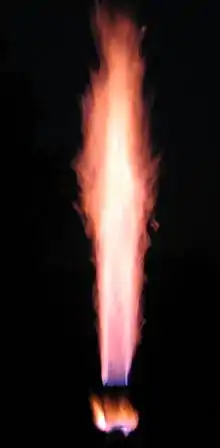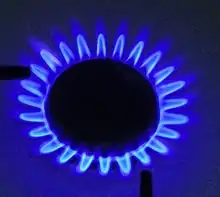Syngas
Syngas, or synthesis gas, is a fuel gas mixture consisting primarily of hydrogen, carbon monoxide, and very often some carbon dioxide. The name comes from its use as intermediates in creating synthetic natural gas (SNG)[1] and for producing ammonia or methanol. Syngas is usually a product of coal gasification and the main application is electricity generation. Syngas is combustible and can be used as a fuel of internal combustion engines.[2][3][4] Historically, it has been used as a replacement for gasoline, when gasoline supply has been limited; for example, wood gas was used to power cars in Europe during WWII (in Germany alone half a million cars were built or rebuilt to run on wood gas).[5] However, it has less than half the energy density of natural gas.[1]

Syngas can be produced from many sources, including natural gas, coal, biomass, or virtually any hydrocarbon feedstock, by reaction with steam (steam reforming), carbon dioxide (dry reforming) or oxygen (partial oxidation). It is a crucial intermediate resource for production of hydrogen, ammonia, methanol, and synthetic hydrocarbon fuels. It is also used as an intermediate in producing synthetic petroleum for use as a fuel or lubricant via the Fischer–Tropsch process and previously the Mobil methanol to gasoline process.
Production methods include steam reforming of natural gas or liquid hydrocarbons to produce hydrogen, the gasification of coal,[6] biomass, and in some types of waste-to-energy gasification facilities.
Production
The chemical composition of syngas varies based on the raw materials and the processes. Syngas produced by coal gasification generally is a mixture of 30 to 60% carbon monoxide, 25 to 30% hydrogen, 5 to 15% carbon dioxide, and 0 to 5% methane. It also contains lesser amount of other gases.[7]
The main reaction that produces syngas, steam reforming, is an endothermic reaction with 206 kJ/mol methane needed for conversion.
The first reaction, between incandescent coke and steam, is strongly endothermic, producing carbon monoxide (CO), and hydrogen H
2 (water gas in older terminology). When the coke bed has cooled to a temperature at which the endothermic reaction can no longer proceed, the steam is then replaced by a blast of air.
The second and third reactions then take place, producing an exothermic reaction—forming initially carbon dioxide and raising the temperature of the coke bed—followed by the second endothermic reaction, in which the latter is converted to carbon monoxide, CO. The overall reaction is exothermic, forming "producer gas" (older terminology). Steam can then be re-injected, then air etc., to give an endless series of cycles until the coke is finally consumed. Producer gas has a much lower energy value, relative to water gas, due primarily to dilution with atmospheric nitrogen. Pure oxygen can be substituted for air to avoid the dilution effect, producing gas of much higher calorific value.
When used as an intermediate in the large-scale, industrial synthesis of hydrogen (principally used in the production of ammonia), it is also produced from natural gas (via the steam reforming reaction) as follows:
In order to produce more hydrogen from this mixture, more steam is added and the water gas shift reaction is carried out:
The hydrogen must be separated from the CO
2 to be able to use it. This is primarily done by pressure swing adsorption (PSA), amine scrubbing, and membrane reactors.
Alternative technologies
Biomass catalytic partial oxidation
Conversion of biomass to syngas is typically low-yield. The University of Minnesota developed a metal catalyst that reduces the biomass reaction time by up to a factor of 100.[8] The catalyst can be operated at atmospheric pressure and reduces char. The entire process is autothermic and therefore heating is not required. Another process has been developed at DTU Energy which is efficient and does not have any issues of fouling of the catalyst (in this case a cerium oxide catalyst)[9][10]
Carbon dioxide and methane
A two-stage method developed in 2012 produces syngas consisting only of carbon monoxide and hydrogen. In a first step, methane is decomposed at a temperature of more than 1000 °C, thus forming a mixture of carbon and hydrogen[11] (reaction: CH4 + energy -> C + 2 H2). Preferably, a plasma heater provides heating in the first step. In a second step, CO2 is added to the hot mixture of carbon and hydrogen[12] (reaction: C + CO2 -> 2 CO). The carbon and the CO2 react at high temperature to form carbon monoxide (reaction: C + CO2 -> 2 CO). The mixture of carbon monoxide from the second step and hydrogen from the first step thus forms a high-purity syngas consisting only of CO and H2.
Alternatively, water can be used instead of CO2 in the second step to achieve a higher amount of hydrogen in the syngas.[13] In this case, the reaction of the second step is: C + H2O -> CO + H2. Both methods also allow to vary the ratio of CO to H2.
Microwave energy
CO2 can be split into CO and then combined with hydrogen to form syngas . A method for production of carbon monoxide from carbon dioxide by treating it with microwave radiation is being examined by the solar fuels-project of the Dutch Institute For Fundamental Energy Research. This technique was alleged to have been used during the Cold war in Russian nuclear submarines to allow them to get rid of CO2 gas without leaving a bubble trail.[14] Publicly available journals published during the Cold War indicate that American submarines used conventional chemical scrubbers to remove CO2.[15] Documents released after the sinking of the Kursk, a Cold War era Oscar-class submarine, indicate that potassium superoxide scrubbers were used to remove carbon dioxide on that vessel.
Solar energy
Heat generated by concentrated solar power may be used to drive thermochemical reactions to split carbon dioxide to carbon monoxide or to make hydrogen.[16] Natural gas may be used as a feedstock in a facility that integrates concentrated solar power with a power plant fueled by natural gas augmented by syngas while the sun is shining.[17][18][19]
Co-electrolysis
By employing co-electrolysis, i.e. the combined electrochemical conversion of steam (H
2O) and carbon dioxide (CO
2) to carbon monoxide (CO) with the use of renewably generated electricity, syngas can be produced in the framework of a CO
2-valorization scenario, allowing for a closed carbon cycle.[20]
Electricity
Use of electricity to extract carbon dioxide from water[21][22][23][24][25] and then water gas shift to syngas has been trialled by the US Naval Research Lab. This process becomes cost effective if the price of electricity is below $20/MWh.[26]
Renewable sources
Electricity generated from renewable sources is also used to process carbon dioxide and water into syngas through the high-temperature electrolysis. This is an attempt to maintain carbon neutral in the generation process. Audi, in partnership with company named Sunfire, opened a pilot plant in November 2014 to generate e-diesel using this process.[27]
Uses
Gas lighting
Coal gasification processes to create syngas were used for many years to manufacture illuminating gas (coal gas) for gas lighting, cooking and to some extent, heating, before electric lighting and the natural gas infrastructure became widely available. The syngas produced in waste-to-energy gasification facilities can be used to generate electricity.
Energy capacity
Syngas that is not methanized typically has a lower heating value of 120 BTU/scf .[28] Untreated syngas can be run in hybrid turbines that allow for greater efficiency because of their lower operating temperatures, and extended part lifetime.[28]
Sponge iron
Syngas is used to directly reduce iron ore to sponge iron.[29]
Diesel
Syngas can be used in the Fischer–Tropsch process to produce diesel, or converted into e.g. methane, methanol, and dimethyl ether in catalytic processes.
If the syngas is post-treated by cryogenic processing, it should be taken into account that this technology has great difficulty in recovering pure carbon monoxide if relatively large volumes of nitrogen are present due to carbon monoxide and nitrogen having very similar boiling points which are –191.5 °C and –195.79 °C respectively. Certain process technology selectively removes carbon monoxide by complexation/decomplexation of carbon monoxide with cuprous aluminum chloride (CuAlCl
4) dissolved in an organic liquid such as toluene. The purified carbon monoxide can have a purity greater than 99%, which makes it a good feedstock for the chemical industry. The reject gas from the system can contain carbon dioxide, nitrogen, methane, ethane, and hydrogen. The reject gas can be further processed on a pressure swing adsorption system to remove hydrogen, and the hydrogen and carbon monoxide can be recombined in the proper ratio for catalytic methanol production, Fischer-Tropsch diesel, etc. Cryogenic purification, being very energy-intensive, is not well suited to simply making fuel, because of the greatly reduced net energy gain.
Hydrogen
Syngas is used to produce hydrogen for the Haber process.
Waste to energy
In an Australia, Logan City Council will use the gasification process to dramatically shrink the volume of waste needing to be trucked off site and produce syngas to power the facility. Once wastewater is treated to kill off harmful pathogens and bacteria, the remaining biosolids will be heated to high temperatures to produce a synthetic gas made up of mostly hydrogen, carbon monoxide, methane and carbon dioxide.[30]
See also
References
- Beychok, M.R., Process and environmental technology for producing SNG and liquid fuels, U.S. EPA report EPA-660/2-75-011, May 1975
- "Syngas Cogeneration / Combined Heat & Power". Clarke Energy. Retrieved 22 February 2016.
- Mick, Jason (3 March 2010). "Why Let it go to Waste? Enerkem Leaps Ahead With Trash-to-Gas Plans". DailyTech. Archived from the original on 4 March 2016. Retrieved 22 February 2016.
- Boehman, André L.; Le Corre, Olivier (2008). "Combustion of Syngas in Internal Combustion Engines". Combustion Science and Technology. 180 (6): 1193–1206. doi:10.1080/00102200801963417. S2CID 94791479.
- "Wood gas vehicles: firewood in the fuel tank". LOW-TECH MAGAZINE. Retrieved 2019-06-13.
- Beychok, M.R., Coal gasification and the Phenosolvan process, American Chemical Society 168th National Meeting, Atlantic City, September 1974
- "Syngas composition". National Energy Technology Laboratory, U.S. Department of Energy. Retrieved 7 May 2015.
- "Syngas Production Using a Biomass Gasification Process". University of Minnesota. Retrieved 22 February 2016.
- New route to carbon-neutral fuels from carbon dioxide discovered by Stanford-DTU team
- Selective high-temperature CO2 electrolysis enabled by oxidized carbon intermediates
- "dieBrennstoffzelle.de - Kvaerner-Verfahren". www.diebrennstoffzelle.de. Retrieved 2019-12-17.
- "US 9,452,935 B2 - Process and system for conversion of carbon dioxide to carbon monoxide". worldwide.espacenet.com. European Patent Office. Retrieved 2019-12-17.
- "US 9,309,125 B2 - Process and system for generating synthesis gas". worldwide.espacenet.com. European Patent Office. Retrieved 2019-12-17.
- NWT magazine 6/2012
- Carey, R.; Gomezplata, A.; Sarich, A. (January 1983). "An overview into submarine CO2 scrubber development". Ocean Engineering. 10 (4): 227–233. doi:10.1016/0029-8018(83)90010-0.
- "Sunshine to Petrol" (PDF). Sandia National Laboratories. Retrieved April 11, 2013.
- "Integrated Solar Thermochemical Reaction System". U.S. Department of Energy. Retrieved April 11, 2013.
- Matthew L. Wald (April 10, 2013). "New Solar Process Gets More Out of Natural Gas". The New York Times. Retrieved April 11, 2013.
- Frances White. "A solar booster shot for natural gas power plants". Pacific Northwest National Laboratory. Retrieved April 12, 2013.
- "Power-to-Syngas - an enabling technology for the transition of the energy system? Production of tailored synfuels and chemicals using renewably generated electricity". S. Foit, I.C. Vince, L.G.J. de Haart, R.-A. Eichel, Angew. Chem. Int. Ed. (2016) http://onlinelibrary.wiley.com/doi/10.1002/anie.201607552/abstract
- http://www.dtic.mil/get-tr-doc/pdf?AD=ADA544002
- http://www.dtic.mil/get-tr-doc/pdf?AD=ADA539765
- http://www.dtic.mil/get-tr-doc/pdf?AD=ADA589263
- http://www.dtic.mil/get-tr-doc/pdf?AD=ADA565466
- http://www.dtic.mil/get-tr-doc/pdf?AD=ADA544072
- Patel, Prachi. "A Cheap Trick Enables Energy-Efficient Carbon Capture". technologyreview.com. Retrieved 7 April 2018.
- "Audi in new e-fuels project: synthetic diesel from water, air-captured CO2 and green electricity; "Blue Crude"". Green Car Congress. 14 November 2014. Retrieved 29 April 2015.
- Emmanuel O. Oluyede. "FUNDAMENTAL IMPACT OF FIRING SYNGAS IN GAS TURBINES". Clemson/EPRI. CiteSeerX 10.1.1.205.6065. Cite journal requires
|journal=(help) - CHATTERJEE, AMIT (2012-09-12). SPONGE IRON PRODUCTION BY DIRECT REDUCTION OF IRON OXIDE. PHI Learning Pvt. Ltd. ISBN 9788120346598.
- "Sewage treatment plant smells success in synthetic gas trial - ARENAWIRE". Australian Renewable Energy Agency. Retrieved 2021-01-25.

